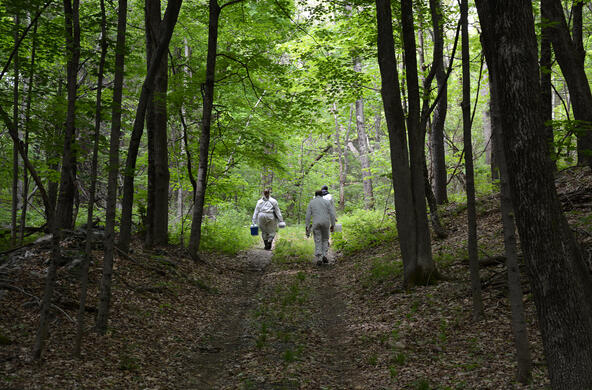Given the 300,000 new cases of Lyme disease a year in the US reported by the CDC, it is understandable that health organizations and local governments in this country are extremely anxious to develop a broader, more effective tick-borne diseases control strategy. As you will discover today in Part 11 of my global series, "Ticks," finding community-wide solutions to infected ticks is going to be challenging.
Before one can tackle the tick problem, it is important to understand how Lyme disease emerges and spreads. As the CDC's Lyle Petersen explained to me, the ticks have four life stages: egg, larvae, nymph and adult. To get to the next life stage, the tick must take a blood meal. When the infected nymphs take a blood meal, whomever they bite can become infected and this is when most people get the disease. Adult ticks are also capable of transmitting infections picked up from animal carriers of the bacteria.
Which animals play a role in spreading infected ticks? Where are people exposed to infected ticks? What ideas and possible solutions are being considered to reduce the ecological risks for individuals and indeed entire communities?
To answer my questions, I am joined by Dr. Richard Ostfeld, Senior Scientist at the Cary Institute of Ecosystem Studies and author of the acclaimed book, Lyme Disease: The Ecology of a Complex System (Oxford University Press, 2011), and Dr. Lyle Petersen, Director of the Division of Vector-Borne Diseases at the Centers for Disease Control and Prevention (the CDC).
Richard, can you please indicate the list of animal carriers of infected ticks that your research has identified to date?
Our research strategy is to quantify the roles of every mammal and bird host we can get our hands on. So we go out and catch everything from tiny shrews to songbirds to deer, bring them temporarily into the lab, and determine how many ticks feed on them, how many try to feed but get killed when the host grooms, and how many get infected with the Lyme spirochete. What we've found is that white-footed mice are the most important hosts in producing infected ticks. Eastern chipmunks and both short-tailed shrews and masked shrews also produce quite a few infected ticks. Pretty much all the other things we've studied, including gray squirrels, red squirrels, flying squirrels, opossums, raccoons, skunks, deer, robins, veeries, wood thrush, and gray catbirds, are much less important in producing infected ticks. These animals kill lots of ticks when they groom themselves, and the ticks that do survive and successfully feed on them do not get infected. So, these species largely play protective roles when it comes to human risk of Lyme disease.
So Richard, the tick that carries Lyme disease is not the deer tick and you believe that four small mammals (including the white footed mouse) host 50% of ticks that account for 90% of the infected ticks? Please explain how your studies bring you to these conclusions.
"Deer tick" was the common name given to the tick shortly after the discovery of Lyme disease, when this tick was thought to be a newly discovered species. Later, it was determined to be a northern population of a tick species, the blacklegged tick (Ixodes scapularis) that had been described many decades earlier. The misnomer "deer tick" persists, though, and can mislead people about the degree to which the tick is associated with deer.
To estimate the percentage of the tick population that feeds on each host and gets infected from each host, we spent years catching multiple individuals of every mammalian and avian host we could possibly find in our area (Dutchess County, NY). We included more than a dozen mammals and several ground-dwelling birds in these samples, although we know there are a few tick-hosts we didn't catch (e.g., coyotes and bobcats). For each host species, we determine: (1) the average number of larval ticks that feeds on an individual host; (2) the proportion of larval ticks that get infected with Borrelia burgdorferi when they feed on that species of host; and (3) the average population density of that species of host (individual per hectare). We then use a simple model to estimate the total number of infected nymphs (the dangerous stage) per hectare that is produced by each host species and by the entire community. This allows us to estimate what percentage of ticks feed on, and get infected from mice and other small mammals.
What would your solutions be to reducing the ecological risks of human exposure to Lyme disease?
Richard: We know that high biodiversity of vertebrate hosts "dilutes" the impact of mice and reduces Lyme disease risk. So, preserving larger, intact forest will reduce risk by protecting that biodiversity. In areas of low diversity and high mouse abundance, such as small forest fragments, we can target tick-control or personal protection measures to reduce risk.
There are several species of native forest floor fungi that attack and kill ticks. The development of strains that are highly pathogenic to ticks and specific to ticks would be a very important development in the production of products homeowners could use to safely and effectively reduce tick populations.
Several labs (including mine) are working on bait vaccines targeted at white-footed mice that can strongly reduce their probability of infected blacklegged ticks. If these vaccines could be deployed widely, the infection prevalence of ticks could be strongly reduced. Such a product, especially if combined with tick control, could reduce human exposure quite strongly.
Host-targeted acaricides/insecticides can be effective as well. There are products that attract hosts to feeding stations where they self-apply an acaricide that reduce the number of ticks on the hosts and in the environment. A version of this exists for deer and another for small mammals. Although these products are not without their problems, they seem to be fairly effective in some circumstances.
Various natural products are being evaluated as environmentally safe and effective alternatives to chemical acaricides in killing ticks in residential and natural areas. Provided that they are safe for vertebrate animals (including people and pets), safe for the environment, and effective at killing ticks, such products could be enormously important in protecting health.
Lyle: It's clear that there is no one easy solution or product to effectively kill ticks and prevent disease. In the meantime, until we find an effective community-wide approach to tick management, people will continue to be bitten, get sick and suffer with disease. We must work together on a paradigm for tick control and disease prevention, focusing on communities.
Lyle, what programs have you put in place or are you planning going forward?
CDC's latest challenge is to develop safe, effective, economical and community-accepted tick-control measures. Given the large number of ticks in the environment and the large geographic area where Lyme and other tick-borne diseases are found, this is a daunting task. Developing a practical and acceptable tick-control approach for communities to embrace that will minimize the risk of bites and diseases from infected ticks in the environment is not as easy as it may seem.
To develop an effective tick-control strategy, three key questions must first be answered.
1. Where are most people exposed to Lyme disease infected ticks - on their own property or elsewhere?
2. To what extent will an individual homeowner approach reduce the risk of Lyme and other tick-borne diseases? Or will an entire neighborhood or community need to be treated to significantly reduce risk?
3. What are the best ways to reduce the risk of Lyme disease either on individual properties or in entire neighborhoods or communities?
CDC is working on answers to these questions, but we still have a lot to learn from three key ongoing studies. A large study has been completed to examine the benefit of pesticides sprayed around the perimeter of individual properties. Final results of this study will be available in 2014. Another study is examining where people are exposed to ticks. A third study is looking at the impact of pesticide treated bait boxes on tick populations on individual properties. The bait boxes contain a wick impregnated with the insecticide Fipronil. This is the same chemical that is used in dog tick control products like Frontline. The bait boxes eliminate ticks on rodents that carry the Lyme disease bacteria, and thus break the natural transmission cycle of Lyme disease over a wider area than can be practically achieved by pesticide application.
Lyle, how do you anticipate local communities helping to resolve these issues?
To continue progress towards identifying an effective tick control strategy, CDC needs to evaluate the efficacy of broader community-wide interventions, including deer management, reduction of ticks on deer, and neighborhood bait box placement, either as single measures or in combination for reducing Lyme disease incidence.
Given the lack of a failsafe method to eliminate tick exposure, communities should reinforce measures that people can take to reduce exposure to Lyme disease bacteria, such as avoiding tick habitats, performing tick checks and showering after being in areas that might harbor ticks. Communities can also implement measures such as deer management or reducing ticks on deer. Communities that take these measures should look at their impact on Lyme disease incidence so others can learn from their experience.








